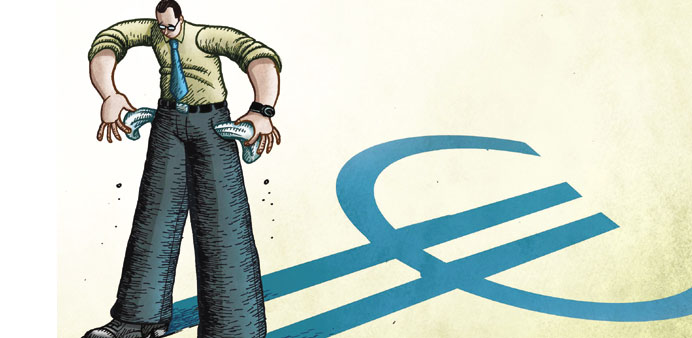Europe is in a difficult predicament. Inflation has fallen to 0.4% and economic growth has been anaemic for years. Though the European Central Bank (ECB) has kept interest rates close to zero, private credit growth is stalling and public debt continues to rise.
This sounds a lot like Japan’s situation in the 1990s, which culminated in a “lost decade” of economic stagnation and deflation from which the country is still working to recover. Is Europe bound for a similar fate?
The parallels between the European and Japanese economies’ trajectories are undeniable. Both experienced a prolonged debt-fueled real-estate and asset-price boom, followed by a deep balance-sheet recession.
As wealth was wiped out and wages contracted, consumption growth collapsed. More damaging, prices for real estate and financial assets plummeted, but the liabilities remained – a major shock for businesses and the financial sector.
Indeed, the combination of declining collateral and rising bad debt squeezed Japanese banks, which were too weakly capitalised to bear large losses.
To avoid a surge of insolvencies, they rolled over corporate debt, bringing about a long and painful period of financial consolidation, low investment and slow economic growth.
To compensate for weak private demand, the government increased spending, more than doubling the stock of public debt, to more than 230% of GDP, in just 15 years.
Fortunately, such an outcome is not inevitable for the eurozone. Though some eurozone countries had real-estate bubbles, they were less extreme than Japan’s in the 1980s, and the ensuing losses were smaller.
Moreover, while mortgage debt rose sharply in some eurozone countries, the increase was moderate in others and completely absent in Germany. Likewise, the excess borrowing by companies in Spain, Portugal and Ireland was largely offset by relatively sustainable borrowing in the eurozone’s three economic heavyweights – Germany, France, and Italy – where the need to deleverage is thus limited.
Finally, the correction in European asset prices was smaller. In fact, eurozone stock-market indices have already made up many of their losses since 2007; by contrast, Japan’s Nikkei 225 Stock Average Index remains around 15,000, compared with a peak of nearly 40,000 in 1989.
Europe has another important advantage: it can learn from Japan’s mistakes. Perhaps the most grievous of these was the Japanese government’s failure to pursue growth-enhancing structural reforms – a result of the country’s difficult political environment.
Even Prime Minister Shinzo Abe’s government, with its huge popular mandate, has struggled to make headway in contentious areas like agriculture and labour markets.
The eurozone, despite facing significant political constraints of its own, seems to be more inclined to pursue such reforms. Indeed, the debt crisis has already forced Spain, Portugal, Greece, and Ireland to implement wide-ranging reforms, and Italy may soon follow suit.
Another lesson from Japan concerns monetary policy.
But, contrary to popular belief, that lesson is not that the central bank should shift swiftly to expansionary monetary policy, as the ECB did at the beginning of the eurozone crisis.
Though the Bank of Japan (BOJ) hesitated before initiating such a shift in 1991, it then cut interest rates aggressively and began injecting large amounts of liquidity into the economy.
Japan’s real monetary-policy lesson is that prolonged monetary accommodation with near-zero rates enables banks to delay any serious effort to clean up their balance sheets.
For about eight years after the crisis began, banks simply used their massive stocks of government bonds as collateral to obtain liquidity from the BOJ, which they then used to finance loans to weak companies.
The result was widespread financial forbearance, often described as “zombie lending”.
The good news is that the ECB, recognising this danger, has been calling for a rigorous cleanup of European banks’ balance sheets and is submitting the banks under its supervision to an asset quality review and stress tests. The bad news is that extreme monetary accommodation continues to undermine these efforts.
Europe cannot avoid a Japanese-style lost decade just by upping the dose of monetary medicine. No amount of extra liquidity will entice overleveraged companies and households to borrow more. This was the case for Japan in the 1990s, and it is true for the eurozone (and the US) today.
Nonetheless, though monetary policy has not helped to kick-start growth in the eurozone, many observers continue to argue that, in order to help governments address their fiscal challenges, the ECB must launch quantitative easing (large-scale purchases of long-term assets).
That is what Japan did, with the result that the BOJ is now the largest holder of Japanese sovereign debt, with around ¥200tn ($1.96tn) in government bonds.
Moreover, 10-year bond yields for Spain and Italy are already close to US levels, and are much lower for France. Reducing borrowing costs further would diminish the incentive for governments to put their fiscal houses in order.
Meanwhile, the ECB would be acting as a fiscal agent, redistributing risk and administering sizeable financial transfers among eurozone countries. As a result, the entire eurozone could fall into a trap of rising public debt and weak economic growth – just like Japan.
Of course, governments need to spend more to smooth the deleveraging process – but only temporarily. As Japan’s experience shows, prolonged fiscal and monetary stimulus is not a recipe for faster growth. Europe’s leaders should heed that experience.
Unfortunately, it is far from certain that they will. - Project Syndicate
*Michael Heise is Chief Economist at Allianz SE and the author of Emerging From the Euro Debt Crisis: Making the Single Currency Work.



